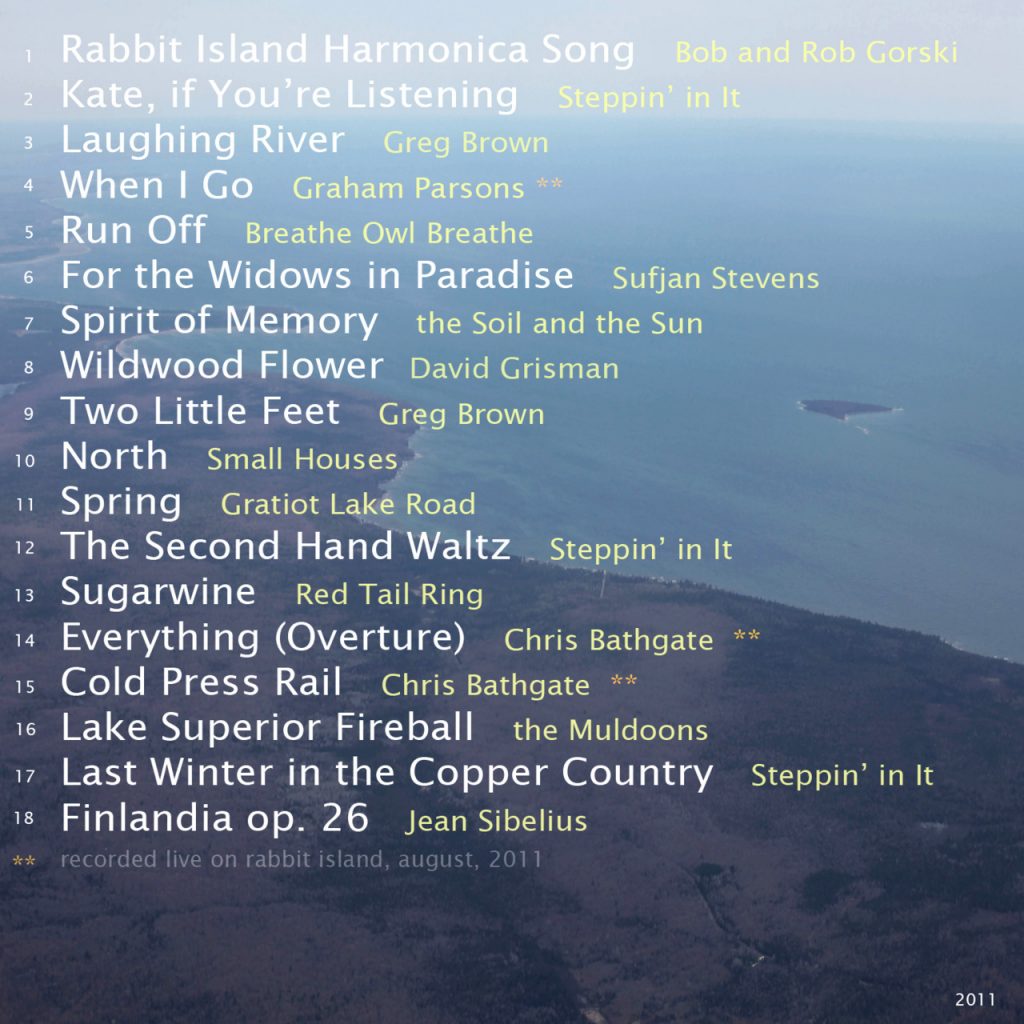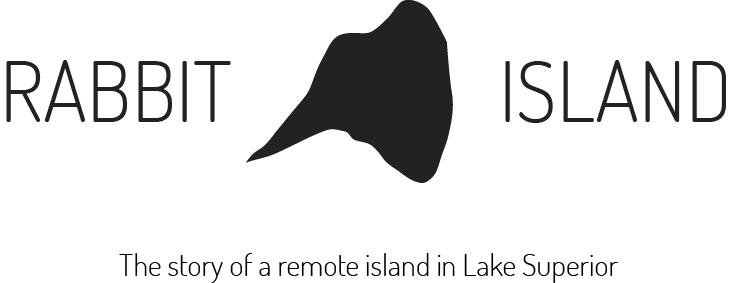
The Rabbit Island Mixtape. This is a list of works that have come from the northern Michigan community or relate in some way to the spirit of our project. Over the last few summers many of them have set the tone on the island. A few are fresh discoveries that we decided to take a chance on. Three of the tracks were recorded live on Rabbit Island this past August (one by Graham Parsons and two by Chris Bathgate and friends). As island ideas move along we hope that songs like these will continue to set a tempo rooted as much in the past as in the future and begin to symbolize an ethic that is evolving to address ideas that are much larger than 91 acres. The last track, Finlandia, is significant regionally because of the strong Finnish in the blood of many locals. Historically the composition represented the idea of quintessential Finnish Sisu that inspired resistance of the Russians during the Winter War of 1939-40. We like to think of it, however, in a context that moves beyond nationalism to a time when works like this are inspired by issues even more fundamentally classic than country–sustainability, the balance of liberty and environment, the wise application of creative energy, etc. So that is how we have appropriated it and that is how it should be listened to. It is a beautiful work. We can’t link a direct download to the playlist unfortunately because we aren’t, well, iTunes, but you can download the tracks directly from the artists if you like.
1. Rabbit Island Harmonica Song by Bob and Rob Gorski
2. Kate, if You’re Listening by Steppin In It
3. Laughing River by Greg Brown
4. When I Go by Graham Parsons**
5. Run Off by Breathe Owl Breathe
6. For the Widows in Paradise by Sufjan Stevens
7. Spirit of Memory by the Soil and the Sun
8. Wildwood Flower by David Grisman
9. Two Little Feet by Greg Brown
10. North by Small Houses
11. Spring by Gratiot Lake Road
12. The Second Hand Waltz by Steppin’ In It
13. Sugarwine by Red Tail Ring
14. Everything (Overture) by Chris Bathgate**
15. Cold Press Rail by Chris Bathgate**
16. Lake Superior Fireball by the Muldoons
17. Last Winter in the Copper Country by Steppin’ in It
18. Finlandia op. 26 by Jean Sibelius
** Recorded live of Rabbit Island, August, 2011
Il n'y a plus de déserts. Il n'y a plus d'iles. Le besoin pourtant s'en fait sentir. Pour comprendre le monde, il faut parfois se détourner; pour mieux servir les hommes, les tenir un moment à distance. Mais où trouver la solitude nécessaire à la force, la longue respiration où l'esprit se rassemble et le courage se mesure?
There are no more deserts. There are no more islands. Yet there is a need for them. In order to understand the world, one needs to turn away from it on occasion; in order to serve men better, one needs to hold them at a distance for a time. But where can one find the solitude necessary to vigor, the deep breath in which the mind collects itself and gauges its strength?
- Camus (from l'ete, 1954)
Lake Superior Fireball – The Muldoons (Sycamore Smith and Scotty Alan)
Cassie Marketos over at Kickstarter posted a few follow-up questions/answers about some of our summer projects. Lots of good everyday island stuff in here as told by Andrew.
Good poster. It is all over New York right now. Reorganization is definitely destined to become a central idea in our civic lives. Conservation as the endpoint needs to give way to the broader idea of reorganization as we more fully realize the historical misalignment of land development relative to science and art by society. It is pretty clear that in the context of a globe that has been crisscrossed by subdivision at every temperate latitude, the low hanging fruit of simple conservation has been picked and the results have been only partially successful in terms of any larger conceptual framework. The argument for a movement towards reorganization (in America especially) is pretty basic; our national westward development trend and historical culture of subdivision (and individual liberty) outpaced our scientific knowledge and governmental organization by several hundred years, leaving us with an undesigned hodge-podge mosaic that is not aligned with contemporary understanding of ecological fundamentals. (Who knew at the time that the picket fence dream and a middle finger towards anything collective would slowly undermine the equally American pillar of nature?) It isn’t very stylish. It isn’t organized neatly. It isn’t serving the spirit of the people well. We need a redo. This is especially so east of the Rockies and west of the Sierras. Maybe the Guggenheim Lab could make a stop at Rabbit Island. There isn’t a Whole Foods across the street but whatever. We’ll figure something out.
Thomas Transtromer won the 2011 Nobel Prize in Literature for poetry inspired by a small Scandinavian island in the Swedish archipelago. His work explores the idea of city vs. country. In his case the city is Stockholm while contrast is found on the remote island of Runmarö.
Further In
On the main road into the city
when the sun is low.
The traffic thickens, crawls.
It is a sluggish dragon glittering.
I am one of the dragon’s scales.
Suddenly the red sun is
right in the middle of the windscreen
streaming in.
I am transparent
and writing becomes visible
inside me
words in invisible ink
which appear
when the paper is held to the fire!
I know I must get far away
straight through the city and then
further until it is time to go out
and walk far in the forest.
Walk in the footprints of the badger.
It gets dark, difficult to see.
In there on the moss lie stones.
One of the stones is precious.
It can change everything
it can make the darkness shine.
It is a switch for the whole country.
Everything depends on it.
Look at it, touch it…
A Place in the Forest
On the way there a pair of startled wings clattered up — that was all. You go alone. A tall building that consists entirely of cracks, a building that is perpetually toppling but can never collapse. The thousandfold sun floats in through the cracks. In this play of light an inverted law of gravity prevails: the house is anchored in the sky and whatever falls, falls upward. There you can turn around. There you are allowed to grieve. You can dare to face certain old truths kept packed, in storage. The roles I have, deep down, float up, hang like dried skulls in the ancestral cabin on some out-of-the-way Melanesian islet. A childlike aura circles the gruesome trophies. So mild it is, in the forest.
From March 1979
Tired of all who come with words, words but no language
I went to the snow-covered island.
The wild does not have words.
The unwritten pages spread themselves out in all directions!
I come across the marks of roe-deer’s hooves in the snow.
Language but no words.
The first european known to have set foot on Rabbit Island was a Swedish immigrant known from the remaining historical records as Berg. The island was originally named Berg Saari–a combination of his surname and the Finnish word for island. Last July we found the remnants of his wood stove from the late 1880’s, several mason jars (one which was still capped and filled with liquid), tin pans and the few remaining logs that he used for the walls of his primitive cabin.
Becoming familiar with Tomas Transtromer’s work 130 years later in the context of Rabbit Island will be nice. The source of his inspiration is no doubt the same, wherever it exists.
